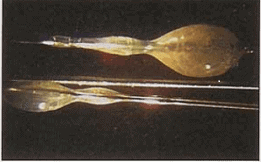Increasingly popular, sensors provide vital monitoring capabilities for many systems, and enable product designers to add exciting functionality to other devices.
When it’s all said and done, the accuracy and reliability of even the most commonplace sensor depends on components being within exacting specifications and able to withstand the most extreme conditions for their applications, whether heavy duty usage, harsh environments, or even low usage, where the sensor is normally “out there waiting.” iniscule products, such as ultra fine “sensing” wires or fine wires used in making electronic connections are among the critical components that are sometimes underspecified when it comes to materials and protective coatings, a situation that can put an entire system or mission at risk.
The correct fine wire specification for sensor electronics is a value added service California Fine Wire has to offer design engineers.
“When you consider that the accuracy or lifespan of the sensor, and therefore the system is at stake, it’s often just not practical to pecify off the shelf fine wire products.There is frequently a specific metal alloy or bimetal laminate or protective coating that will do the job better and perform under abnormal conditions, or conditions due to an application the sensor manufacturer did not anticipate,” said Mike Greenelsh, president of California Fine Wire (CFW), of Grover Beach, CA. CFW is a pioneer in the manufacture of fine and ultrafine ire, and produces a variety of up to 1000 combinations of metals and alloys.
“Fine wire products are used in highly sophisticated devices, where the physics of the wire’s primary function is the focus of the design engineer,” explained Greenelsh. “But if the device, and hence the wire, will be subjected to an external stresses such as vibration or extreme temperatures, that usually indicates the need for a metal or coating that will enable the wire to withstand the stresses.”
One of CFW’s customers, Analytical Industries, of Pomona, CA, drives home the significance of incorporating the appropriate material and also processing into the specification of the fine wire used in their sophisticated products. The company manufactures sensors used for medical, industrial, automotive, food processing and personal safety applications.
Patrick Prindible, vice-president and co-founder, says his firm’s primary products are electrochemical sensors that monitor gases for ontaminants such as oxygen. For example, in natural gas pipelines,Analytical Industries’ oxygen analyzer sensors sample natural gas pipelines for oxygen that indicates a leak in a pipeline due to corrosion or some other damage.
Analytical Industries’ electrochemical sensors use a special fine wire ribbon, normally silver or gold-plated silver, approximately 0.0015 to 0.002 in. thick for internal connections, and 0.005 in nickel wire for external connections.
“These wires are attached to pins, from which we bring negative and positive wire foil leads from inside the sensor tube to a small circuit board attached to the back. One of the internal foils is positive, and the other negative; connecting them creates the circuit needed for an operating sensor,”Prindible explained.
 Wire with improper coating will cause failures due to lack of proper insulation. The proper wire and coating (such as PTFE) combination for a specific application will ensure a long fasting device even in harsh environments.
Wire with improper coating will cause failures due to lack of proper insulation. The proper wire and coating (such as PTFE) combination for a specific application will ensure a long fasting device even in harsh environments.The fine wires used in these sensors are critical as far as metal purity and tolerances are concerned. “If the metal is thicker than our specification, it hinders the performance of the sensor,” Prindible said. “What it amounts to is that any oxygen molecules have too far to travel before they reach the sensing surface.”
Prindible also points out if the metal is either too thick or too thin, it becomes brittle for an “interference fit” that obviates the need for a life shortening weld, and can fracture, which will break the critical circuit or otherwise dramatically reduce performance and product life.
Until a few years ago, Analytical Industries was buying wire ribbon (foils) from a couple of suppliers, and having it plated by yet another vendor. “Many times we had sporadic quality with the plated wire,” Prindible said, “so we sought out another supplier.recalled having sourced products from CFW when worked for another company, so decided to contact them. Not only could CF W provide the wire we needed to the needed specifications, but they could perform the plating operation as well. And to cap that, they could do both operations for a lower price than we had been paying. But most importantly, they provide us with consistent quality, which is what we were really looking for.”
Greenelsh says CF’W sales engineers can provide insight into coatings such as paralene and PTFE. CFW developed a proprietary process that enables them to apply liquified PTFE to fine wires in continuous lengths of up to 10,000 ft. After the PTFE is applied, the wire is then run through a furnace to set the new coating. This process can be repeated to develop a thicker PTFE cover and can even be applied on top of other types of coatings if the customer so specifies.
Specifically shaped fine wire is another area of enhancement for consideration as it may be square or rectangular with rounded corners, hexagonal or a variety of other geometric possibilities, including ribbon. The shape specified can relate to a broad range of requirements, such as current carrying capacity, flexibility, corrosion resistance and temperature related characteristics. Most these properties also relate to metals and other materials from which the wire is made.


